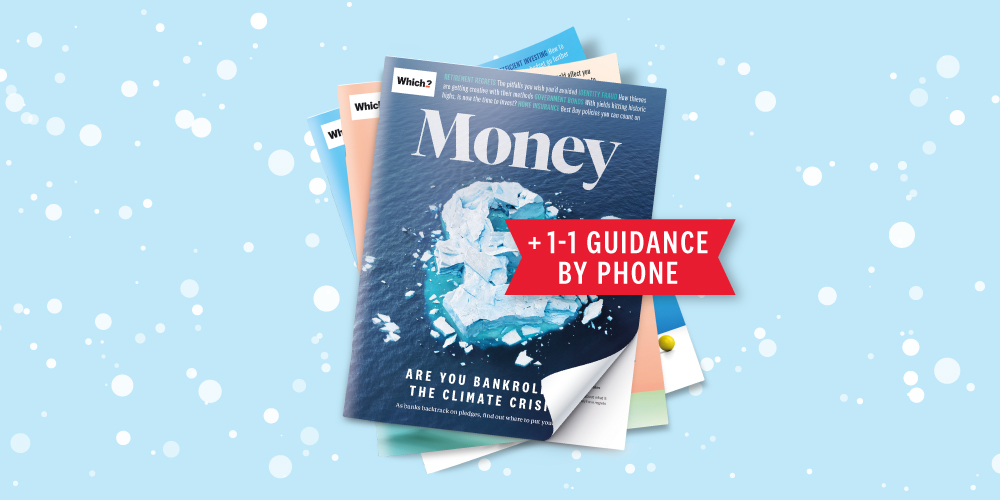
Get a year of super-useful advice
Get the best deals, avoid scams, and grow your savings with expert guidance all year for only £36.75 that’s 25% off.
Join Which? MoneyOffer ends 8th January 2026
By clicking a retailer link you consent to third-party cookies that track your onward journey. This enables W? to receive an affiliate commission if you make a purchase, which supports our mission to be the UK's consumer champion.

Nearly a third of Which? members say being able to open a savings account in a branch is important – but it may mean settling for lower returns.
Our analysis shows that choosing a savings account with branch access could mean you miss out on hundreds of pounds in interest, with app-only deals often outpacing high street rates.
Here, Which? explores which accounts pay less, and what’s holding some savers back from going digital.

Get the best deals, avoid scams, and grow your savings with expert guidance all year for only £36.75 that’s 25% off.
Join Which? MoneyOffer ends 8th January 2026
For many savers, managing money in a branch still matters — whether it’s ease, trust or accessibility.
In our August 2025 survey of more than 1,000 Which? members, 28% said in-branch access was important when managing their savings. And of those with a savings account or cash Isa, one in five opened it in a branch.
While online rates may be higher, not everyone feels comfortable managing their money digitally.
For older savers or those with limited internet access, high street branches offer face-to-face support and a sense of security that apps can’t always replicate.

Keith Raper considers himself lucky that he is computer literate, but his in-laws struggle to get online. When they needed to open new savings and cash Isa accounts recently, the 70-year-old from Liverpool stepped up and drove them to a high street bank branch.
'They are in their mid-90s, still live in their own home and do not do online, email, texts or mobile phones, so for them, physical bank branches are vital,' he explains.
'They also both have hearing aids and find it difficult to fully understand and follow detailed conversations on the telephone. Without his hearing aids, my father-in-law is almost completely deaf, so he often lip reads if he can’t hear properly, which requires him to be facing the person he is talking to.'
Raper adds that bank branches also offer older savers the opportunity to discuss deeper financial issues face to face with bank staff that are difficult or impossible to cover with online banking.
Our analysis of savings accounts on 21 October 2025 reveals that deals offering in-branch access typically pay lower interest than those that are online-only or app-based.
The difference is most stark on instant-access accounts, but branch-based savers are likely to lose out across the board.
| Access type | Branch | Online | App-only |
|---|---|---|---|
| Average rate | 2.12% | 3.02% | 3.34% |
The biggest gap is in instant-access savings. On a £5,000 balance, the difference between branch and online rates adds up to around £45 a year, or £225 over five years.
There are exceptions – Santander’s Edge Saver, for instance, pays 6% AER, but is limited to existing current-account customers and includes a 2.5% bonus for 12 months before dropping to 3.5%.
By contrast, Cahoot’s Sunny Day Saver offers 5% AER on balances up to £5,000, with no linked-account requirement or bonus conditions.
Among app-only options, Snoop’s instant-access account, paying 4.35% AER, stands out. It doesn’t require a current account or include a temporary bonus, showing how competitive mobile-only providers have become.
| Access type | Branch | Online | App-only |
|---|---|---|---|
| Average rate for one-year fix | 3.85% | 4.02% | 4.17% |
The difference is smaller on fixed-rate savings, but branch-based savers are still losing out.
The average interest for a branch access fix lasting more than a year is 3.83% AER compared to 3.93% for an online account.
But while the difference in returns appears tiny, the extra interest earned in an online account can soon add up if you have a larger lump sum tucked away.
Given that you’ll likely only need to interact with a fixed account twice (at opening and maturity), you might want to consider whether branch access is really worth the interest trade-off.
While the top-paying fixed-rate accounts are largely offered by online providers, app-only banks are among the few attractive options if you’ve got less than the typical minimum deposit of £1,000.
Atom Bank's one-year bond, for example, allows you to start saving with just £50, while with Zopa the minimum is £1.
| Access type | Branch | Online | App-only |
|---|---|---|---|
| Average rate on instant-access | 2.53% | 2.88% | 3.72% |
Cash Isas operate in a similar way to traditional savings accounts, with a range of instant-access and fixed-rate deals to choose from. However, they differ in important ways.
Unlike savings accounts, where interest earned over your personal savings allowance is taxed, you can deposit up to £20,000 a year in an Isa without paying a penny on returns to HMRC. Rates also tend to get a boost at the end of the tax year and the start of a new one.
Our analysis found instant-access cash Isas with branch access pay an average 2.53% AER. But going online will bag you a higher average rate of 2.88%.
Again, app-only instant-access cash Isas pay the most - an average 3.72% AER. That's almost one percentage point more than an in-branch product
For one-year fixed Isas, branch-access accounts pay an average of 3.88% compared with 4.04% online. For longer-term fixes, the figures are 3.79% versus 3.91%.
There are just two one-year app-only fixed Isas on the market: from Tembo Money and Zopa, paying 4.27% and 4.22% respectively. The average rate for a cash Isa lasting more than one year is 3.85%.
The table shows the top rates currently available for instant-access, fixed-rate, and cash Isa savings accounts, ordered by term. Results exclude those with restrictions on who can open the account, limits on withdrawals and temporary introductory bonuses.
The columns also show the minimum investment needed, opening methods and when the interest is paid.
| Instant access | Cahoot | 5% (a) | 61% | £1 | Internet | Monthly, yearly |
| Instant access cash Isa | Plum | 4.45% | n/a | £1 | Mobile app | Monthly |
| One-year fixed rate | LHV Bank | 4.46% | n/a | £1,000 | Mobile app | On maturity |
| One-year fixed rate cash Isa | Investec Bank plc | 4.27% | n/a | £1,000 | Internet | On maturity |
| Two-year fixed rate | JN Bank | 4.42% | n/a | £100 | Internet | Yearly |
| Two-year fixed rate cash Isa | UBL UK | 4.16% | n/a | £2,000 | Branch, internet, mobile app, postal | Monthly, anniversary, on maturity |
| Three-year fixed rate | DF Capital | 4.47% | n/a | £1,000 | Internet | Yearly, on maturity |
| Three-year fixed rate cash Isa | UBL UK | 4.12% | n/a | £2,000 | Branch, internet, mobile app, postal | Monthly, quarterly, anniversary, on maturity |
| Four-year fixed rate | JN Bank | 4.45% | n/a | £100 | Internet | Yearly |
| Four-year fixed rate cash Isa | UBL UK | 4.00% | n/a | £2,000 | Branch, internet, mobile app, postal | Monthly, quarterly, anniversary, on maturity |
| Five-year fixed rate | DF Capital | 4.54% | n/a | £1,000 | Internet | Yearly, on maturity |
| Five-year fixed rate cash Isa | Castle Trust Bank | 4.22% | n/a | £1,000 | Internet, mobile app | On maturity |
Table notes: rates sourced from Moneyfacts on 21 October 2025. Provider customer score is based on savers' overall satisfaction with the brand and how likely they are to recommend it to others. n/a means sample size was too small for us to generate a provider score (a) Offers 5% AER up to £3,000.

Find the right savings account for you using the service provided by Experian Ltd
Compare and chooseAs the table shows, you can only open an account offering any of the top deals on savings accounts (including instant-access and one- two-, three-, four- or five-year fix) online or through a mobile app.
There is good news for cash Isa savers looking for a market-leading rate, however. Despite the overall average being lower than online or app-only products, the top two-, three- and four-year fixed-rate cash Isas all offer the option of opening an account in-branch.
One simple explanation is that providing digital-only accounts costs less.
Smaller, so-called challenger banks that don’t offer services at a physical branch have fewer overheads, so they can afford to offer higher interest rates while still maintaining profit margins.
‘Challenger banks have lower running costs due to their more digital, streamlined approach, which leads to better rates for savers,’ explains Rachel Springall, Moneyfacts finance expert.
‘Not only this, but it is essential these institutions manage the flow of money into the business to fuel their future lending, so offering a high savings rate is a great way to draw in new deposits.’
It’s a point that's not lost on Which? member Keith Raper, who said online banks have been able to 'cherry-pick the most profitable parts of retail banking' while high street banks are left to cover the cost of running branches.
Our survey also found concerns about the safety and security of digital banking were common among those savers who told us branch access is important them.
One member explained:
'I cannot be scammed if I don't use the website or the telephone. I also don't trust any financial institution with keeping my personal information safe.'
Another said:
'I do not do any internet banking, as I do not trust it - or me - to use it safely. Besides which, it is more open to scammers.'
If you're nervous about saving with a bank or platform you've never heard of, there are some checks you can perform to ensure your money is protected.
A good starting point is to find out whether the bank or platform is covered by the Financial Services Compensation Scheme (FSCS). This protects up to £85,000 of a saver's pot if it goes bust. Challenger banks have to abide by the same rules and regulations as other banks, but not all of them are FSCS-protected.
For example, while Monzo, Starling and Zopa have banking licences in the UK, some companies, such as Monese, operate under electronic or 'e-money' licences instead. This means that although money must be ring-fenced in a segregated account, you don't get direct protection from the FSCS.
It's also a good idea to check what features the provider offers to ensure your banking app is as secure as possible, minimising the impact if your phone gets stolen.
Many digital banks have location-based protections to prevent fraudulent payments where the location of the card and the app don't match. Others use biometric technology, such as your voice and face, to secure the app.
Before opening an account, you need to compare rates and access options across banks. Our guide to the best savings accounts explains how to find top rates and highlights Which? Recommended Providers for service and reliability.
When comparing, think about how quickly you might need your money and how long you can lock it away. You might prefer one flexible account, or several with different terms.
Always check the fine print for withdrawal limits or penalties in case your circumstances change.